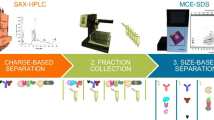Abstract
Chromatographic separation of proteins by the gradient elution method using DEAE Toyopearl 650® was carried through. The concentration gradient was effected by changing the ionic strength of NaCl in the carrier buffer solution. Bovine serum albumin and hemoglobin were used as model proteins for separation. The experimental chromatogram was compared with theoretical results of Yamamoto et al. [1, 2]. Adsorption equilibria of the proteins onto the carrier were measured and expressed by a function of the ionic strength. The retention volume and peak width of the resulting chromatogram can be calculated from the equilibrium data using the Yamamoto theory. The calculated results agreed well with the experimental data.
The method presented in this paper will be useful to predict the viability of ion-exchange chromatography in protein separation.
Similar content being viewed by others
Abbreviations
- c kg m−3 :
-
concentration in the liquid phase
- c s kg m−3 :
-
concentration in the solid phase
- D s m2 s−1 :
-
intraparticle diffusivity
- d p m:
-
particle diameter
- E z m2 s−1 :
-
longitudinal diffusivity of the protein
- E z I m2 s−1 :
-
longitudinal diffusivity of ionic strength
- H :
-
ɛ/(1 − ɛ)
- I kmol m−3 :
-
ionic strength
- I O kmol m−3 :
-
initial ionic strength
- I p kmol m−3 :
-
ionic strength at the peak
- I s kmol m−3 :
-
ionic strength in the solid phase
- ΔI/ΔV mol (dm3)−2 :
-
slope of the ionic gradient elution
- m :
-
distribution coefficient
- m ∞ :
-
distribution coefficient at I → ∞
- m I :
-
distribution coefficient for ionic strength
- Q cm3s−1 :
-
flow rate
- R m:
-
particle radius
- R s :
-
degree of separation
- r m:
-
radial position inside particles
- t s:
-
time
- u m s−1 :
-
linear velocity
- V cm3 :
-
eluted volume of liquid
- V p cm3 :
-
eluted volume of liquid at the peak
- V T cm3 :
-
volume of the packed bed
- W cm3 :
-
peak width
- Z m:
-
bed height
- z m:
-
vertical position in the bed
- z p m:
-
peak position from the inlet of the bed
- δ(t) :
-
delta input at time
- ɛ :
-
void fraction
- μ 1 s:
-
first moment
- μ 2′ s2 :
-
second central moment
- τ s:
-
superficial space time
References
Yamamoto, S.; Nakanishi, K.; Matsuno, R.; Kamikubo, T.: Ion exchange chromatography of proteins — prediction of elution curves and operating conditions. I. Theoretical considerations. Biotechnol. Bioeng. 25 (1983) 1465–1483
Yamamoto, S.; Nakanishi, K.; Matsuno, R.; Kamikubo, T.: Ion exchange chromatography of proteins — prediction of elution curves and operating conditions. II. Experimental verification. Biotechnol. Bioeng. 25 (1983) 1373–1391
Furusawa, T.; Suzuki, M.; Smith, J. M.: Rate parameters in heterogeneous catalysis by pulse techniques. Catalysis Rev. 13 (1976) 43–76
Dubois, M.; Gilles, K. A.; Hamilton, J. K.; Rebers, P. A.; Smith, F.: Colorimetric method for determination of sugars and related substances. Anal. Chem. 28 (1956) 350–356
Author information
Authors and Affiliations
Rights and permissions
About this article
Cite this article
Furusaki, S., Haruguchi, E. & Nozawa, T. Separation of proteins by ion-exchange chromatography using gradient elution. Bioprocess Engineering 2, 49–53 (1987). https://doi.org/10.1007/BF00369522
Received:
Issue Date:
DOI: https://doi.org/10.1007/BF00369522




